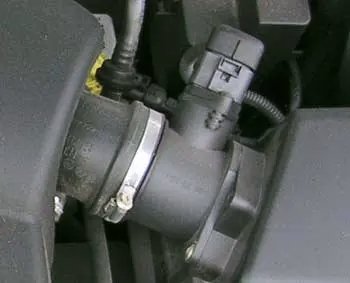Air flow meter sensor
1 comment
The air flow sensor or so-called flow meter (MAF) is one of the key components of your car's electronic fuel injection system. It is placed between the air filter and the intake manifold of the engine. . The air flow sensor measures the amount of air entering the engine or air flow.
In modern cars, an intake air temperature sensor or IAT is built into the air flow sensor. There are few types of air flow sensors, however, modern cars use the hot wire type. Let's see how it works.

The hot wire fatty air flow sensor has a small electrically heated wire (hot wire). A temperature sensor installed near the hot wire measures the air temperature near the hot wire.
When the engine is idling, a small amount of air flows around the hot wire, so very little electricity is needed to keep the wire hot. When you press the gas, the gas opens allowing more air to flow through the hot wire. The passing air cools the wire. The more air that flows through the wire, the more electricity is needed to keep it hot. The electric current is proportional to the amount of air flow. A small electronic chip built inside the air flow sensor translates electricity into a digital signal and sends it to the computer's motor (PCM). The PCM uses an airflow signal to calculate how much fuel to inject. The goal is to keep the air-fuel ratio at an optimal level.

Toyota Air Flow Sensor (MAF)
In addition, the PCM uses airflow readings to determine the shift points of the automatic transmission. If the air flow sensor does not work properly, the automatic transmission may also not work properly.

Problems with airflow sensors are common in many cars, including BMW, GM, Volkswagen, Mazda, Toyota, Nissan and other brands. The sensor element may be contaminated or damaged. For example, in some Mazda Skiactiv engines, a failed airflow sensor could cause the engine to run but not start.
Improperly installed or poor air filter can cause the air flow sensor to malfunction sooner. Excessive soaking of the washable air filter can also cause problems with the air flow sensor.
A contaminated or poor air flow sensor cannot properly measure the amount of air flow. Therefore, the engine computer incorrectly calculates the amount of fuel injected. As a result, a poor airflow sensor causes a variety of driving problems, including immobility, delays, lack of power, and poor acceleration. In addition, a faulty airflow sensor may cause the Check Engine or Service Engine Soon lamp to illuminate.
A problem with the airflow sensor could also change the shift pattern of the automatic transmission.
In modern cars, the only way to test airflow sensors is with a test tool. The mechanics measure and read the flow sensor at different speeds. They compare the readings with the reading specifications or readings of a known good mass flow sensor.
Idle airflow is often read, 1,000 rpm, 2,000 rpm and 3,000 rpm. A contaminated or poor airflow sensor will in most cases show smaller airflow readings than known. In some rare cases, a bad sensor can show higher readings. Of course, different engines will have different readings. The air flow depends on the engine volume, so the V6 or V8 engine will have higher readings.
Low mass airflow reading does not mean that the sensor is bad. A clogged air filter or a connected catalytic converter can also cause smaller readings of the air flow sensor. Leakage of the vacuum also affects the reading of the air flow sensor. That's why mechanics use a well-known sensor to compare readings.
Pozdrav od Mrkija 🇷🇸 - Greetings from Mrky 🇺🇸
Comments